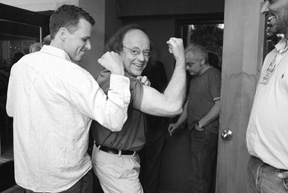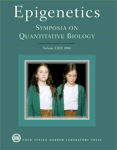|
LXIX: Epigenetics 2004 |
|
|

|
From left: I.Hall, J. Birchler SYMPOSIUM SYNOPSIS LIST OF PARTICIPANTS CONTENTS OF SYMPOSIUM VOLUME PHOTOGRAPHS PUBLISHED VOLUME  |
Epigenetics
May 28 - June 2, 2004
Symposium Synopsis
Meeting Organized by Bruce Stillman and David Stewart
Until recently, the general view of heredity has been seen through the lens of DNA. Indeed, the 2003 Symposium on "The Genome of Homo sapiens" contributed to that view by emphasizing the importance of DNA sequence and its origins. But increasingly, investigators are exploring a set of secondary phenomena that give rise to heritable changes in gene function that occur without a change in the underlying DNA sequence—epigenetic mechanisms such as DNA methylation, histone acetylation, imprinting, RNA interference, gene silencing, and paramutation. A growing body of evidence indicates that epigenetic changes are important contributors to the pathogenesis of disease in humans, animals, and plants and may lie at the heart of many important gene–environment interactions. And so it seemed timely to hold a Symposium explicitly devoted to "Epigenetics."
Previous Symposia that have in part examined the role of the macromolecular context in which the primary genetic information is found include the 1941 Symposium on "Genes and Chromosomes: Structure and Organization," which emphasized a biophysical approach to these structures; the two closely separated Symposia that examined "Chromosome Structure and Function" (1973) and "Chromatin" (1977), at which latter meeting the nature of the nucleosome was unveiled; and the 1993 Symposium on "DNA and Chromosomes," by which time the human genome project with its focus on the primary sequence was well underway. The 69th Symposium, however, was the first to fully explore the heritable aspects to these and related biochemical phenomena.
The field of epigenetics as we know it today was prominently introduced at the 1951 Symposium on "Genes and Mutations." There, Ed Lewis presented data on position effect variegation in Drosophila, a phenomenon that has played an important role in the history of the field. Equally importantly, Barbara McClintock presented her ideas about heterochromatin and movable genetic elements, the so-called Ac-Ds system in maize that opened up understanding of transposition and its links to gene silencing and formation of heterochromatin. Some 53 years later, the 69th Symposium witnessed a rather complete molecular description of her ideas, including links to RNAi.
The 69th Symposium ran for 5 days and included 460 participants with 68 oral presentations and 210 poster presentations. We wish to thank Dr. David Haig for his superb Dorcas Cummings Memorial public lecture presenting a theoretical approach to epigenetics, on the subject of The Divided Self—Brains, Brawn and the Superego. We also wish to thank the first night speakers, Drs. Davor Solter, Barbara Meyer, David Allis, and Andrew Fire for their superb overview presentations, and we particularly thank Dr. Daniel Gottschling for agreeing to summarize the Meeting.
We thank Jenna Williams and Mary Smith in the Meetings and Courses office for efficiently running the meeting and John Inglis and his staff at the Cold Spring Harbor Laboratory Press, particularly Joan Ebert, Kathleen Bubbeo, and Danny deBruin, for publishing both the on-line and printed versions of the meeting manuscripts. Essential funds to run this meeting were obtained from the National Cancer Institute, a branch of the National Institutes of Health. In addition, financial help from the corporate benefactors, sponsors, affiliates, and contributors of our meetings program is essential for these Symposia to remain a success and we are most grateful for their continued support.
Bruce Stillman
David Stewart
March 2005
Search images: